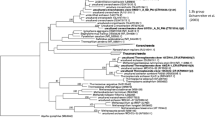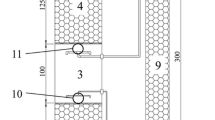Abstract
The microbial community structure of twenty-one single-phase and one two-phase full-scale anaerobic sewage sludge digesters was evaluated using oligonucleotide probes complementary to conserved tracts of the 16S rRNAs of phylogenetically defined groups of methanogens and sulfate-reducing bacteria. These probe results were interpreted in combination with results from traditional chemical analyses and metabolic activity assays. It was determined that methanogens in “healthy” mesophilic, single-phase sewage sludge digesters accounted for approximately 8–12% of the total community and thatMethanosarcinales andMethanomicrobiales constituted the majority of the total methanogen population.Methanobacteriales andMethanococcales played a relatively minor role in the digesters. Phylogenetic groups of mesophilic, Gram-negative sulfate-reducing bacteria were consistently present at significant levels:Desulfovibrio andDesulfobulbus spp. were the dominant sulfate-reducing populations,Desulfobacter andDesulfobacterium spp. were present at lower levels, andDesulfosarcina, Desulfococcus, andDesulfobotulus spp. were absent. Sulfate reduction by one or more of these populations played a significant role in all digesters evaluated in this study. In addition, sulfate-reducing bacteria played a role in favoring methanogenesis by providing their substrates. The analysis of the two-phase digester indicated that true phase separation was not accomplished: significant levels of active methanogens were present in the first phase. It was determined that the dominant populations in the second phase were different from those in the single-phase digesters.
Similar content being viewed by others
References
Amann RI, Binder BJ, Olson RJ, Chisholm SW, Devereux R & Stahl DA (1990) Combination of 16S rRNA-targeted oligonucleotide probes with flow cytometry for analyzing mixed microbial populations. Appl. and Environ. Microbiol. 56: 1919–1925
Archer DB & Powell GE (1985) Dependence of the specific growth rate of methanogenic mutualistic cocultures on the methanogen. Arch. Microbiol. 141: 133–137
Balch WE, Fox GE, Magnum LJ, Woese CR & Wolfe RS (1979) Methanogens: Reevaluation of a unique biological group. Microbiol. Reviews 43: 260–296
Boone DR, Whitman WB & Rouviere P (1993) Diversity and taxonomy of methanogens. In: Ferry JG (Ed) Methanogenesis: Ecology, Physiology, Biochemistry & Genetics, pp 35–80. Chapman & Hall, Inc., New York
Devereux R, Delancy M, Widdel F & Stahl DA (1989) Natural relationships among sulfate-reducing Eubacteria. J. Bacteriol. 171: 6689–6695
Devereux R, He S-H, Doyle CL, Orkland S, Stahl DA, LeGall J, & Whitman WB (1990) Diversity and origin ofDesulfovibrio sp.: Phylogenetic definition of a family. J. Bacteriol. 172: 3609–3619
Devereux R, Kane MD, Winfrey J & Stahl DA (1992) Genus-and group-specific hybridization probes for determinative and environmental studies of sulfate-reducing bacteria. System. and Appl. Microbiol. 15: 601–609
Devereux R & Stahl DA (1993) Phylogeny of sulfate-reducing bacteria and a perspective for analyzing their natural communities. In: Odom JM & Singleton F (Ed) The Sulfate-Reducing Bacteria: Contemporary Perspectives, pp 131–160. New York: Springer-Verlag New York Inc.
Fongastitkul P, Mavinic DS & Lo KV (1994) A two-phased anaerobic digestion process: Concept, process failure and maximum system loading rate. Water Environ. Res. 66: 243–254
Fox P & Pohland FG (1991). Anaerobic treatment applications and fundamentals: substrate specificity during phase separation. In: 65th Annual Conference of the Water Pollution Control Federation in Toronto, Canada
Greenberg AE, Clesceri LS & Eaton AD (1992) Standard methods for the examination of water and wastewater, 18 ed., Washington, D.C.: American Public Health Association
Heppner B, Zellner G & Diekman H (1992) Start-up and operation of a propionate-degrading fluidized-bed reactor. Appl. Microbiol. Biotechnol. 36: 810–816
Jones WJ, Guyot J-P & Wolfe RS (1984) Methanogenesis from sucrose by defined immobilized consortia. Appl. and Environ. Microbiol. 47: 1–6
Metcalf & Eddy (1991) Wastewater engineering, treatment, disposal, and reuse, 3rd Ed, McGraw-Hill Inc.
Owen WF, Stuckey DC, Healy JG, Young LY & McCarty PL (1979) Bioassay for monitoring biochemical methane potential and anaerobic toxicity. Water Res. 13: 485–492
Pohland G & Ghosh S (1971) Developments in anaerobic stabilization of organic wastes — the two-phase concept. Environ. Lett. 1: 255–266
Raskin L (1993) Structural and functional analysis of anaerobic biofilm communities: An integrated molecular and moeling approach. Ph.D. thesis, University of Illinois at Urbana-Champaign
Raskin L, Poulsen LK, Noguera DR, Rittmann BE & Stahl DA (1994a) Quantification of methanogenic groups in anaerobic biological reactors using oligonucleotide hybridization probes. Appl. and Environ. Microbiol. 60: 1241–1248
Raskin L, Stromley JM, Rittmann BE & Stahl DA (1994b) Group-specific 16S rRNA hybridization probes to describe natural communities of methanogens. Appl. and Environ. Microbiol. 60: 1232–1240
Raskin L, Amann RI, Poulsen LK, Rittmann BE & Stahl DA (1995) Use of ribosomal RNA based molecular probes for characterization of complex microbial communities in anaerobic biofilms. Water Science Technol. 31: 261–272
Risatti JB, Capman WC & Stahl DA (1994) Community structure of a microbial mat: The phylogenetic dimension. Proc. Natl. Acad. Sci. USA. 91: 10173–10177
Speece RE (1988) A survey of municipal anaerobic sludge diesters and diagnostic activity assays. Water Res. 22: 365–372
Stahl DA & Amann R (1991) Development and application of nucleic acid probes. In: Stackebrandt E & Goodfellow M (Ed) Nucleic acid techniques in bacterial systematics, pp 205–248. John Wiley & Sons Ltd
Stahl DA, Flesher B, Mansfield HR & Montgomery L (1988) Use of phylogenetically based hybridization probes for studies of ruminal microbial ecology. Appl. and Environ. Microbiol. 54: 1079–1084
Tabatabai MA (1974) Determination of sulphate in water samples. Sulphur Institute Journal, 11–13
Tasaki M, Kamagato Y, Nakamura K, Okamura K & Minami K (1993) Acetogenesis from pyruvate and differences in pyruvate metabolism among three sulfate-reducing bacteria in the absence of sulfate. FEMS Microbiol. Lett. 106: 259–264
Traore AS, Fardeau M-L, Hatchikian CE, Gall JL & Belaich J-P (1983) Energetics of growth of a defined mixed culture ofDesulfovibrio vulgaris andMethanosarcina barkeri: interspecies hydrogen transfer in batch and continuous cultures. Appl. and Environ. Microbiol. 46: 1152–1156
Widdel F (1988) Microbiology and ecology of sulfate- and sulfur-reducing bacteria. In: Zehnder AJB (Ed) Biology of anaerobic microorganisms, pp 469–585. John Wiley & Sons, Inc.
Woese CR (1987) Bacterial evolution. Microbiolog. Reviews 51: 221–271
Woese CR, Kandler O & Wheels ML (1990) Towards a natural system of organisms: Proposal for the Domains Archaea, Bacteria, and Eucarya. Proc. Natl. Acad. Sci. USA. 87: 4576–4579
Wu W-M, Hickey RF & Zeikus JG (1991) Characterization of metabolic performance of methanogenic granules treating brewery wastewater: role of sulfate-reducing bacteria. Appl. and Environ. Microbiol. 57: 3438–3449
Yao R, Macario AJL & de Macario EC (1992) Immunochemical differences amongMethanosarcina mazei S-6 morphologic forms. J. Bacteriol. 174: 4683–4688
Zhang TC & Noike T (1991) Comparison of one-phase and two-phase anaerobic digestion processes in characterisctis of substrate degradation and bacterial population levels. Water Science Technol. 23: 1157–1166
Zinder SH (1993) Physiological ecology of methanogens. In: Ferry JG Methanogenesis: Ecology, Physiology, Biochemistry & Genetics, pp 128–206. Chapman & Hall, Inc. New York.
Author information
Authors and Affiliations
Rights and permissions
About this article
Cite this article
Raskin, L., Zheng, D., Griffin, M.E. et al. Characterization of microbial communities in anaerobic bioreactors using molecular probes. Antonie van Leeuwenhoek 68, 297–308 (1995). https://doi.org/10.1007/BF00874140
Accepted:
Issue Date:
DOI: https://doi.org/10.1007/BF00874140




